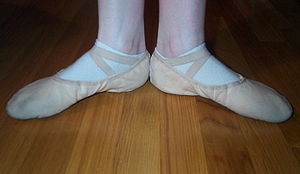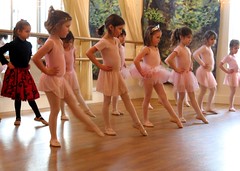 The last profile of 2012 is from Alisha of The Four Eyed Ballerina. She’s got a lot of awesome posts up on her blog, including one about how to make an awesome and easy ballerina bun for class here!
The last profile of 2012 is from Alisha of The Four Eyed Ballerina. She’s got a lot of awesome posts up on her blog, including one about how to make an awesome and easy ballerina bun for class here!
Adult Ballerina Project: When did you start doing ballet as an adult?
Alisha: About 2 1/2 years ago, at age 22.
ABP: Did you ever take lessons as a kid?
A: I did very briefly when I was about 5, but got kicked out because I would just run around and never listen to the teacher. My mom was pretty disappointed.
ABP: Why did you decide to take ballet as an adult?
A: I loved ballet for a really long time and decided it would be a fun way to exercise. I ended up catching on pretty quickly and fell in love with it. Now I don’t think of it as exercise at all, just something I’m really passionate about getting better at.
ABP: Where do you take classes?
A: I take classes at two different studios; I dance at an intermediate level and also take pointe classes.
ABP: What is your favorite part about ballet?
A: The satisfaction you get when suddenly one day something has noticeably improved, like your leg can go higher or something you’ve been struggling with is suddenly just coming together naturally.
ABP: What is your least favorite part?
A: The sweat. Its gross, ok? Some people leave entire puddles on the floor at their spot at the barre. It creeps me out how much sweat and grossness is probably on those barres! But its worth it.
ABP: Who/What is your ballet inspiration?
A: I love Polina Semionovoa. She is such an amazing dancer and I really hope I get to see her dance in person one day;  everything just see,s so effortless for her. As for past ballerinas I really like Gelsey Kirkland and Karen Kain. Gelsey was just so light and sprite-like with so much energy and Karen was such a beauty but also full of strength. I am also inspired by dance photography and music.
everything just see,s so effortless for her. As for past ballerinas I really like Gelsey Kirkland and Karen Kain. Gelsey was just so light and sprite-like with so much energy and Karen was such a beauty but also full of strength. I am also inspired by dance photography and music.
ABP: What motivates you to keep dancing?
A: This is a tough one! It is really hard sometimes to drag yourself to ballet class after work. A lot of the time I show up tired and starving but I find when I don’t go I feel really guilty and when I force myself to go I feel really glad that I’ve gone. So I suppose my motivation is the feeling of accomplishment and happiness that I get from my classes.
ABP: Do you take any other dance classes?
A: Nope, but I do take Yoga classes at work during lunch which I find really helps with flexibility for Ballet.
ABP: What are your hobbies outside of ballet?
A: I am one of those people who has way too many hobbies and not enough time. I love to draw, paint, take photographs, sew, cook, knit, garden, read, bake, hike, canoe, spend time with my animals, and probably other things I am forgetting!
ABP: What advice would you like to give to those who want to start ballet or have just started?
A: It is definitely not easy, and as far as I can tell it never will be! Ballet is not for the faint of heart, you will have to constantly work at it and you will probably look like a fumbling idiot at first, just don’t give up! With a lot of hard work and determination you will start to see improvements; I for example have moved up to an intermediate level in just two years and one of my studios even said I could attend the advanced class if I wanted to, I also have the privilege of getting technically good enough to go en pointe. If I can do it in two years so can you 🙂
ABP: Anything else you’d like to add?
A: Just keep dancing.




